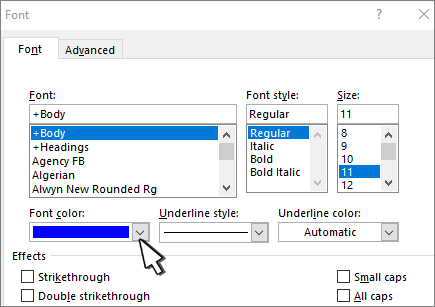

Get really good ideas every day: Subscribe to the Daily Dispatch and Weekly Wrap (it’s free). Illustration © Subscribe to Attorney at Work However, once you reset your default fonts, at least your days of adjusting the fonts every time you start a document are behind you.Ĭlick here to read more of Deborah’s Microsoft Office tips. This doesn’t affect documents you receive from others or any existing documents you created. Now Every New Document You Start in Word Will Use the Microsoft Office Fonts You Prefer Save everything you’ve done by clicking Set as Default on the Design tab (next to the Colors and Fonts buttons). Word will ask whether you want to make this the default for this document only or for all future documents based on the Normal template. Select +Body and the size text you want, then click Set as Default in the lower left-hand corner.

Go to the Home tab and click on the small launcher arrow in the lower right-hand corner of the font section to go to the Font dialog box. Once you reset the font style, the default text size is an easy fix, too. Then you can name your preferred font set before clicking Save. Just use the drop-down for each to find a font more to your liking. This is where you set the two Styles I told you about earlier, +Body and +Headings, which in turn control basic settings for many of the other Styles in a Word document.

On the left, you’ll see Heading font and Body font. That’s going to take you into the Create New Theme Fonts dialog box. From here, you want to choose Customize Fonts. Clicking on Fonts will give you a list of preconfigured font sets. Over on the far right is a drop-down called Fonts. These settings are found in the Design tab (introduced into Microsoft Word with version 2013). In the dialog window that opens, select the All documents based on. In the Font window, change the font attributes to your liking. In the Font section, click the Font Dialog Box Launcher (shown below). Fortunately, you can permanently change just two Styles (+Body and +Headings) to give your documents a more businesslike typeface. Make sure the toolbar is currently on the Home tab. One of the most persistent frustrations legal users have with Microsoft Word fonts is the default font settings. (In this second case, you've overridden how Excel formats a new workbook by whatever is set within the Book.xltx or Book.xltm template file.)Īlso keep in mind that these steps won't change the font in any previously created workbooks those stay as they were when you saved them.If you’re sick of MicroSoft word fonts Calibri and Cambria, change your default heading and body styles so you can start every new Word document with the fonts you prefer. The only times it won't is if you base a new workbook on a template or store a template named Book.xltx or Book.xltm in the XLStart folder. Now every time you create a new workbook, Excel will use these settings as the default. If desired, use the Font Size drop-down list to pick the size of font you want Excel to use.Change the Use this Font drop-down list (Excel 2007 and Excel 2010) or the Use This As the Default Font drop-down list (Excel 2013 and Excel 2016) so that it reflects the font you want used.that you require as the default for your text box font. Then type some text with the font type, size, colour, etc. The General options of the Excel Options dialog box. To change font for all text boxes, first create a text box by clicking Insert, then in the Text group, click Text Box alternatively, to create your text box, click the Text Box button in the Drawing group on the Home tab. Make sure Popular (Excel 2007) or General (Excel 2010 and later versions) is clicked at the left side of the screen.In Excel 2010 and later versions display the File tab of the ribbon and then click Options.) (In Excel 2007 click the Office button and then click Excel Options. All you need to do is follow these steps: Setting the default font that you want Excel to use is actually quite easy. David wonders how he can change the default font for Excel when he opens a new workbook.


 0 kommentar(er)
0 kommentar(er)
